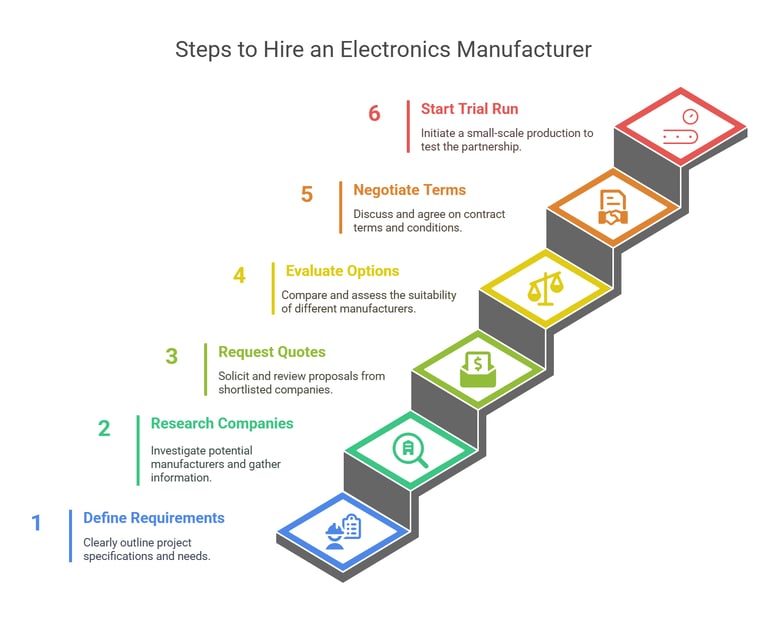How to Hire the Perfect Electronics Manufacturing Company for Your Next Big Project
Choosing the right contract manufacturing partner isn’t just a checkbox on your to-do list—it’s the make-or-break moment for your project. Get it right, and you’re on the fast track to market success. Get it wrong, and you’re stuck with delays, subpar quality, or worse, a blown budget.
3/4/20256 min read


Picture this: You’ve spent months designing an innovative gadget—maybe a sleek wearable, a cutting-edge IoT device, or a life-saving medical tool. Your prototype is ready, your team is buzzing with excitement, and now it’s time to bring your vision to life. But here’s the catch: You need a partner who can turn your blueprints into reality without breaking the bank or missing deadlines. That’s where hiring an electronics manufacturing company comes in.
For designers and decision-makers in electronics development, choosing the right contract manufacturing partner isn’t just a checkbox on your to-do list—it’s the make-or-break moment for your project. Get it right, and you’re on the fast track to market success. Get it wrong, and you’re stuck with delays, subpar quality, or worse, a blown budget.
In this guide, I’ll walk you through why outsourcing electronics production matters, what to look for in a manufacturer, and how to nail the hiring process step-by-step. Whether you’re a startup founder or a seasoned engineer, this is your roadmap to finding the perfect fit. Let’s dive in.
Why Hire an Electronics Manufacturing Company?
First things first: Why not just build everything in-house? For most companies, especially those in electronic product development, the answer boils down to resources. Setting up your own production line sounds great until you tally up the costs—specialized equipment, trained staff, and endless compliance headaches. That’s where an electronics manufacturing company shines.
These pros handle everything from PCB assembly to full-scale production, freeing you up to focus on what you do best: designing and innovating. Think of them as an extension of your team, bringing expertise and cutting-edge tech to the table. Need a quick prototype? They’ve got you covered. Ready to churn out thousands of units? They can scale with you.
The perks don’t stop there. Outsourcing electronics manufacturing slashes overhead costs, speeds up your time-to-market, and gives you access to industry vets who’ve seen it all. From consumer gadgets to automotive sensors and medical devices, these companies cater to every niche. I once chatted with a designer who swore her startup wouldn’t have survived without a manufacturing partner who caught a tiny flaw in their PCB layout—saving them months of rework. That’s the kind of value we’re talking about.
Key Factors to Consider When Hiring an Electronics Manufacturing Company
So, you’re sold on outsourcing. Now comes the hard part: picking the right partner. Not every manufacturer is created equal, and the stakes are high when your reputation’s on the line. Here’s what to keep in mind:
1. Experience and Expertise
You wouldn’t hire a chef who’s never cooked to cater your wedding, right? Same logic applies here. Look for a company with a solid track record in your niche—whether it’s wearables, industrial controls, or RF devices. Ask about their past projects. If they’ve tackled designs like yours before, they’ll know the quirks and challenges that could trip up a newbie.
2. Manufacturing Capabilities
Not all factories are one-size-fits-all. Some excel at rapid prototyping, while others are built for mass production. Dig into their services: Do they offer design support? Surface-mount PCB assembly? Final product testing? If your project needs custom enclosures or complex soldering, make sure they’ve got the tools—and the skills—to pull it off.
3. Quality Standards and Certifications
In electronics, quality isn’t negotiable. A single faulty component could tank your product’s reliability—or worse, your brand. Check for certifications like ISO 9001, which signals a commitment to process, or IPC standards for top-notch assembly. If you’re in a regulated field like medical devices, RoHS or FDA compliance might be non-negotiable too. Ask about their quality control—good manufacturers live and breathe it.
4. Location and Logistics
Domestic or overseas? It’s the age-old question. Local manufacturers offer faster shipping and easier communication, but offshore options (think Asia) often cut costs. I’ve seen teams swear by U.S.-based partners for quick turnarounds, while others rave about the savings from China—just weigh the trade-offs. Lead times, tariffs, and supply chain hiccups can sneak up on you if you’re not careful.
5. Cost and Pricing Transparency
Let’s talk money. Yes, budget matters, but don’t let it blind you. The cheapest quote might skimp on quality or hide fees that hit later. Look for a partner who’s upfront about pricing—breakdowns for materials, labor, and setup are a good sign. A friend in the industry once told me, “You get what you pay for, but you don’t have to overpay either.” Aim for that sweet spot.
6. Communication and Support
Ever tried troubleshooting a design flaw over a spotty email thread? It’s a nightmare. Your manufacturer should be easy to reach and eager to collaborate. During production, you’ll need updates, tweaks, and maybe a little hand-holding. A responsive team can turn a potential disaster into a minor hiccup.
Steps to Hire an Electronics Manufacturing Company
Ready to start hunting? Here’s a foolproof process to find your match:
1. Define Your Project Requirements
Before you even Google “electronics manufacturing services,” get crystal clear on what you need. What’s your product? How many units? What’s the timeline? Budget? Jot down specs—think component types, tolerances, testing needs. The more detailed, the better. I’ve seen vague briefs lead to misquotes and mismatched partners. Nail this step, and you’re halfway there.
2. Research Potential Companies
Time to play detective. Hit up online directories like ThomasNet or Maker’s Row, scour industry forums, or ping your network for recs. Look at their websites—case studies, client lists, and service pages tell you a lot. Check X posts or reviews for unfiltered feedback too. Shortlist 3-5 that vibe with your project.
3. Request Quotes and Proposals
Send out a killer RFQ (Request for Quote). Include your specs, volume, and timeline, and ask for theirs—lead times, costs, capabilities. When proposals roll in, don’t just skim the numbers. Look for clarity and confidence. A solid proposal feels like a handshake; a sloppy one’s a red flag.
4. Evaluate and Compare Options
Narrow it down. Stack your shortlist against the factors above—experience, quality, cost, etc. Call them up or, if you can, visit their facility. I once toured a plant and spotted their testing setup—it sealed the deal. References help too; past clients can spill the real tea.
5. Negotiate Terms and Sign a Contract
Found “the one”? Time to haggle. Nail down timelines, payment terms, and quality guarantees. IP protection is huge—your design’s your baby, so lock it up tight. Sign a contract that covers all bases, and keep a lawyer’s eyes on it if you can.
6. Start with a Trial Run
Don’t go all-in just yet. Kick things off with a prototype or small batch. It’s like a first date—test the chemistry. If they nail it, scale up. If not, you’ve got an out before you’re knee-deep in a mess.


Common Mistakes to Avoid
I’ve seen smart folks trip over these potholes—don’t be one of them:
Price Over Everything: Low bids tempt, but cheap can mean shoddy. Quality trumps a bargain every time.
Ignoring Scalability: Today’s 100-unit run might be 10,000 tomorrow. Pick a partner who can grow with you.
Skipping IP Protection: Horror story: A designer lost their patent to a shady manufacturer. Secure your rights upfront.
Not Checking Creds: Fake certifications happen. Verify everything—refs, certs, the works.
Top Questions to Ask Before Hiring
Still on the fence? Grill them with these:
What’s your experience with [your product type]?
Can you share refs or past project examples?
How do you ensure quality at every step?
What happens if there’s a delay or defect?
What’s your lead time for prototyping vs. production?
Their answers will tell you more than any sales pitch.
Conclusion
Hiring an electronics manufacturing company isn’t just about outsourcing production—it’s about finding a partner who gets your vision and delivers it flawlessly. For designers and decision-makers in electronics development, this choice shapes your product, your timeline, and your bottom line. Take your time, weigh your options, and trust your gut.
Your next big project deserves the best. Start sketching out those requirements today, or reach out to a trusted manufacturer and get the ball rolling. What’s your move?
